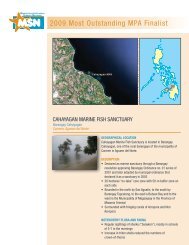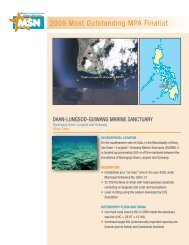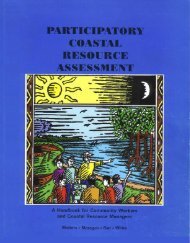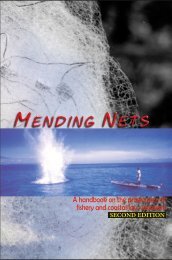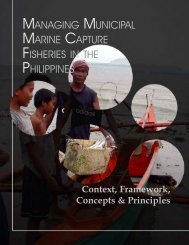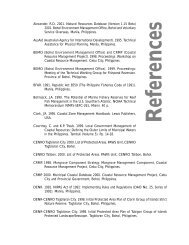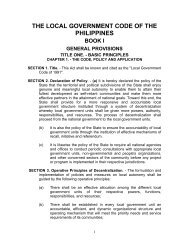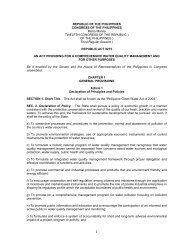Effectiveness of Marine Protected Areas in the Philippines for ...
Effectiveness of Marine Protected Areas in the Philippines for ...
Effectiveness of Marine Protected Areas in the Philippines for ...
You also want an ePaper? Increase the reach of your titles
YUMPU automatically turns print PDFs into web optimized ePapers that Google loves.
Weeks et al. 9<br />
zone <strong>in</strong> open sea, and as such does not conta<strong>in</strong> coral reef.<br />
Ensur<strong>in</strong>g <strong>the</strong> cont<strong>in</strong>ued protection <strong>of</strong> <strong>the</strong>se large no-take<br />
MPAs should be a high priority. Larger and more remote<br />
sites present a greater en<strong>for</strong>cement challenge (White &<br />
Palaganas 1991), but if managed well, funds generated<br />
through tourism can contribute toward costs (Tongson<br />
& Dygico 2004).<br />
Most <strong>of</strong> <strong>the</strong> large MPAs <strong>in</strong> <strong>the</strong> Philipp<strong>in</strong>es allow extractive<br />
activities with<strong>in</strong> <strong>the</strong>ir boundaries. Thus, <strong>the</strong>y provide<br />
little protection to mar<strong>in</strong>e biodiversity. They do, however,<br />
<strong>of</strong>fer an exist<strong>in</strong>g commitment to <strong>the</strong> management<br />
<strong>of</strong> mar<strong>in</strong>e resources. Opportunities may exist to <strong>in</strong>crease<br />
<strong>the</strong> conservation value <strong>of</strong> <strong>the</strong>se sites, ei<strong>the</strong>r through designat<strong>in</strong>g<br />
<strong>the</strong>ir entire area as no-take (Apo Reef Natural Park<br />
was established <strong>in</strong> 1996, but only became fully no-take <strong>in</strong><br />
2007) or by establish<strong>in</strong>g core no-take zones with<strong>in</strong> <strong>the</strong>m.<br />
This approach may be more expedient than identify<strong>in</strong>g<br />
new sites <strong>for</strong> large no-take MPAs.<br />
The number and area <strong>of</strong> MPAs can be mislead<strong>in</strong>g <strong>in</strong>dicators<br />
<strong>of</strong> conservation effectiveness if MPAs are not well<br />
managed and en<strong>for</strong>ced (McClanahan 1999; Chape et al.<br />
2005; Mora et al. 2006). Globally, MPA management effectiveness<br />
is low (Kelleher et al. 1995), and many MPAs<br />
fail to meet <strong>the</strong>ir management objectives (Jameson 2002).<br />
Fisheries benefits <strong>of</strong> MPAs <strong>in</strong> <strong>the</strong> Philipp<strong>in</strong>es are conditional<br />
on good levels <strong>of</strong> en<strong>for</strong>cement and compliance<br />
(Alcala & Russ 2006; Samoilys et al. 2007). The same is<br />
likely to be true <strong>for</strong> conservation benefits. Estimates <strong>of</strong><br />
<strong>the</strong> proportion <strong>of</strong> exist<strong>in</strong>g MPAs that are well managed<br />
and en<strong>for</strong>ced were made with data from <strong>the</strong> <strong>Mar<strong>in</strong>e</strong> <strong>Protected</strong><br />
Area Rat<strong>in</strong>g System (White et al. 2006b). Of <strong>the</strong><br />
251 MPAs surveyed, just 12% are rated as “susta<strong>in</strong>ed,”<br />
which means <strong>the</strong>y have a fully operational en<strong>for</strong>cement<br />
system, management plan, and monitor<strong>in</strong>g program. A<br />
fur<strong>the</strong>r 35% are rated as “en<strong>for</strong>ced.” If <strong>the</strong>se figures are<br />
accurate, our results are optimistic assessments <strong>of</strong> conservation<br />
effectiveness.<br />
A major challenge to quantify<strong>in</strong>g <strong>the</strong> extent <strong>of</strong> any<br />
protected-area system is <strong>the</strong> dynamic nature <strong>of</strong> <strong>the</strong> network<br />
itself and <strong>of</strong> <strong>the</strong> data available about it (Mora et al.<br />
2006). The MPA database we compiled is <strong>the</strong> most comprehensive<br />
to date <strong>for</strong> <strong>the</strong> Philipp<strong>in</strong>es. There are likely<br />
to be more MPAs, however, <strong>for</strong> which data were unavailable.<br />
Ongo<strong>in</strong>g ef<strong>for</strong>ts to collect and verify data <strong>for</strong> exist<strong>in</strong>g<br />
and newly designated MPAs will likely result <strong>in</strong> <strong>the</strong><br />
revised estimates <strong>of</strong> coverage and extent and will allow<br />
more comprehensive assessments <strong>of</strong> <strong>the</strong>ir effectiveness.<br />
Conclusions<br />
Our results <strong>in</strong>dicate an urgent need to expand <strong>the</strong> area<br />
with<strong>in</strong> no-take MPAs <strong>in</strong> <strong>the</strong> Philipp<strong>in</strong>es. This should be<br />
done strategically, to address biases <strong>in</strong> <strong>the</strong> representation<br />
<strong>of</strong> bioregions and target priority areas <strong>for</strong> mar<strong>in</strong>e conservation.<br />
The development <strong>of</strong> systematic, regional-scale<br />
networks <strong>of</strong> MPAs that address both fisheries susta<strong>in</strong>ability<br />
and biodiversity conservation objectives should be<br />
a priority. To better satisfy conservation objectives, we<br />
recommend that <strong>the</strong> Philipp<strong>in</strong>es work on three th<strong>in</strong>gs<br />
to improve MPA implementation and effectiveness. First,<br />
cont<strong>in</strong>ue ef<strong>for</strong>ts to <strong>in</strong>crease <strong>the</strong> number and, where possible,<br />
size <strong>of</strong> community-based MPAs. Second, designate<br />
additional large no-take areas specifically to address conservation<br />
goals. F<strong>in</strong>ally, cont<strong>in</strong>ue to build capacity <strong>of</strong> both<br />
local government-supported MPAs and national agencymanaged<br />
MPAs to improve overall management effectiveness<br />
and governance <strong>of</strong> <strong>in</strong>dividual sites.<br />
Acknowledgments<br />
We thank staff at Coastal Conservation and Education<br />
Foundation and <strong>the</strong> Silliman University Angelo K<strong>in</strong>g Center<br />
<strong>for</strong> Research and Environmental Management <strong>for</strong> assistance<br />
<strong>in</strong> compil<strong>in</strong>g <strong>the</strong> MPA database and support <strong>the</strong>ir<br />
ongo<strong>in</strong>g ef<strong>for</strong>ts to establish MPAs <strong>in</strong> <strong>the</strong> Philipp<strong>in</strong>es.<br />
We are grateful to two anonymous reviewers <strong>for</strong> provid<strong>in</strong>g<br />
helpful comments on an earlier version <strong>of</strong> this<br />
manuscript. R.W. is supported by a Northcote Graduate<br />
Scholarship.<br />
Literature Cited<br />
Abesamis, R. A., A. C. Alcala, and G. R. Russ. 2006. How much does <strong>the</strong><br />
fishery at Apo Island benefit from spillover <strong>of</strong> adult fish from <strong>the</strong><br />
adjacent mar<strong>in</strong>e reserve? Fishery Bullet<strong>in</strong> 104:360–375.<br />
Agardy, T. P. et al. 2003. Dangerous targets? Unresolved issues<br />
and ideological clashes around mar<strong>in</strong>e protected areas. Aquatic<br />
Conservation-<strong>Mar<strong>in</strong>e</strong> and Freshwater Ecosystems 13:353–367.<br />
Airame, S., J. E. Dugan, K. D. Lafferty, H. Leslie, D. A. McArdle, and<br />
R. R. Warner. 2003. Apply<strong>in</strong>g ecological criteria to mar<strong>in</strong>e reserve<br />
design: a case study from <strong>the</strong> Cali<strong>for</strong>nia Channel Islands. Ecological<br />
Applications 13:S170–S184.<br />
Alcala, A. C., and G. R. Russ. 2006. No-take mar<strong>in</strong>e reserves and reef<br />
fisheries management <strong>in</strong> <strong>the</strong> Philipp<strong>in</strong>es: a new people power revolution.<br />
Ambio 35:245–254.<br />
Alcala, A. C., G. R. Russ, A. P. Maypa, and H. P. Calumpong. 2005.<br />
A long-term, spatially replicated experimental test <strong>of</strong> <strong>the</strong> effect <strong>of</strong><br />
mar<strong>in</strong>e reserves on local fish yields. Canadian Journal <strong>of</strong> Fisheries<br />
and Aquatic Sciences 62:98–108.<br />
Almany, G. R., M. L. Berumen, S. R. Thorrold, S. Planes, and G. P. Jones.<br />
2007. Local replenishment <strong>of</strong> coral reef fish populations <strong>in</strong> a mar<strong>in</strong>e<br />
reserve. Science 316:742–744.<br />
Areco, H. O., W. L. Campos, F. Fuentes, and P. M. Al<strong>in</strong>o. 2004. Proceed<strong>in</strong>gs<br />
<strong>of</strong> <strong>the</strong> workshops towards <strong>the</strong> <strong>for</strong>mulation <strong>of</strong> <strong>the</strong> Philipp<strong>in</strong>e<br />
<strong>Mar<strong>in</strong>e</strong> Sanctuary Strategy. University <strong>of</strong> <strong>the</strong> Philipp<strong>in</strong>es <strong>Mar<strong>in</strong>e</strong><br />
Science Institute, Diliman, Quezon City. Also available from http://<br />
www.elib.gov.ph/details.php?uid=8f92581a9ecad86851e6cf42ba<br />
31b102.<br />
Beyer, H. L. 2004. Hawth’s analysis tools <strong>for</strong> ArcGIS. SpatialEcology.com.<br />
Available from http://www.spatialecology.com/htools<br />
(accessed September 2008).<br />
Burke, L., E. Selig, and M. Spald<strong>in</strong>g. 2002. Reefs at risk <strong>in</strong> Sou<strong>the</strong>ast Asia.<br />
World Resources Institute, Wash<strong>in</strong>gton, D.C.<br />
Carpenter, K. E. 2005. The center <strong>of</strong> <strong>the</strong> center <strong>of</strong> mar<strong>in</strong>e shore fish<br />
biodiversity: <strong>the</strong> Philipp<strong>in</strong>e Islands. Environmental Biology <strong>of</strong> Fishes<br />
72:467–480.<br />
Conservation Biology<br />
Volume **, No. *, 2009



